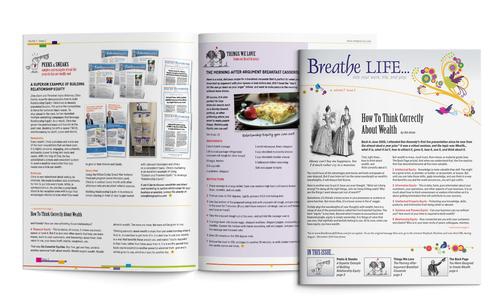
We are a print marketing agency, and love creating beautiful print newsletters. However, I will say for the record that we do not recommend sending an email version of your print newsletter.
Marketing via print is a different beast than marketing via email
Mass emailing (i.e email marketing) is an excellent and effective way to stay in front of your prospects and increase your sales. But like all marketing, there are principles you should follow to give you the best results possible.
For example, unlike your print newsletter, your email “newsletter” doesn't need to be fancy with lots of graphics and fonts and prettiness. That’s all good and well for your print newsletter, but not for email.
Why?
Because email is a very personal, one-to-one mode of communication.
When you email a friend, or even a colleague, do you add a big pretty header at the top? Or write your message in a two-column format? With headlines? And a cute stock image?
No. No, you don’t.
If you want to connect with your subscribers, and make your message feel personal, then you write it as if you’re writing to a real person. A fancy, highly formatted email immediately signals to the recipient that he has just received a mass email and reading it is entirely optional, in fact he can and should just delete it.
One of the best teachers of email marketing is Ben Settle. He drills down on principles that work not just for email marketing, but for many other areas of business, marketing, and life in general. You can subscribe to Ben Settle’s email list here.
Now back to email newsletters...
If you still insist on emailing a multi-topic newsletter, here are a few tips to get started correctly:
1. For heaven's sake, please don’t announce that it’s a newsletter in the subject line: Our January Newsletter! Give it an interesting a headline that will at least get the reader curious to see what you have to say. If you can’t come up with one, reuse a headline from the content.
2. Instead of writing or linking to multiple topics, consider using just one article from your print newsletter, and make that the topic of your email. Again, this is because emails are very personal, so you want your email to sound like it is coming from you, not from your marketing team. A single topic or message is more likely to come from one person. A multi-topic email is a team effort.
3. Write in conversational tone, not too short to be useless, not too long to require focus. An email message that requires dedicated and focused attention from the recipient runs the risk of being deleted or skipped over to read later. But forgotten about.
People already have short attention spans when it comes to print media. That attention span is even shorter in digital media.
Finally, just like with all marketing, there should always be an offer and a call-to-action in every email. Sure, email might be free compared to print marketing. But, unless you are always actively moving the prospect forward to the next step, you are wasting your time and their time.
If you're not subscribed to the Zine Newsletter, you can do so here, and see examples of these strategies right in your mailbox.

